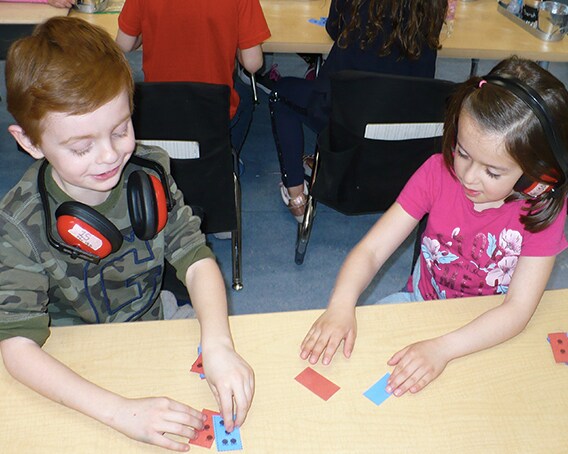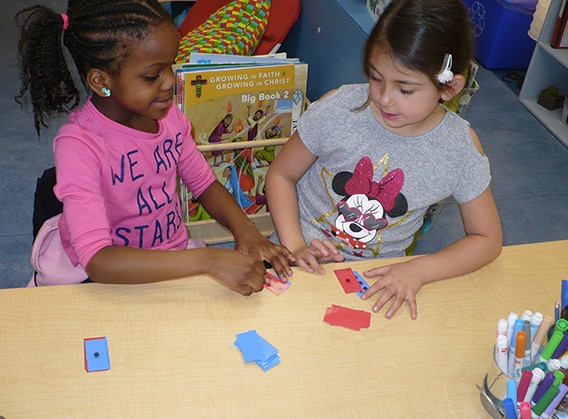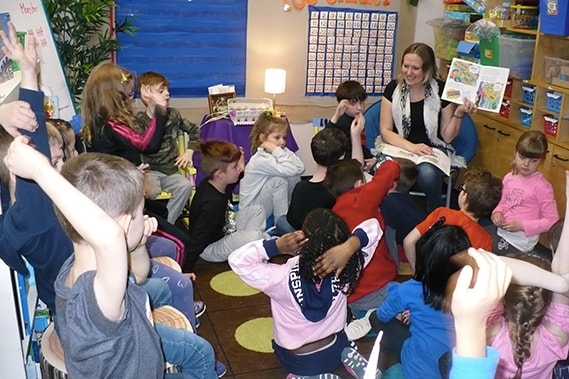Growing students’ math vocabulary and making real-life math connections
Mathology resources help address difficulties in teaching math
By Wendy McMahon
In her 11 years of teaching grade-one math, Cheryl Stadnick has noticed two consistent issues. First, students often don’t understand math vocabulary and second, they rarely see a connection between math and real life.
That leads to confused, disengaged students who don’t internalize math concepts and can’t draw on that knowledge later when they need it.
But Stadnick, who teaches at Madonna Catholic School, in Sherwood Park Alberta, says teaching with Mathology resources has changed all that. It’s put math lessons into contexts that students understand and get excited about. As a result, her students connect with and retain what they've learned.
“The types of conversations we have with Mathology are so rich, they tell me students are not memorizing facts, they understand their facts.”
Cheryl Stadnick

Learning math language
“When I started teaching, I found there was something about the math terminology that kids really had trouble understanding,” says Stadnick.
For example, her students could understand the terms “more” or “less” on their own. But when she used both terms in the same lesson students got confused.
She tried extra spelling lists, but that didn’t help. At the end of the year, students struggled to even remember the names of the math symbols for adding, equals and subtraction.
But Stadnick says the meaningful conversations students have when they read Mathology Little Books and the related questions from the teacher’s guide help create a deep understanding of vocabulary. And Mathology’s activity cards add to the learning by helping students see math concepts in action.

“It’s like going deep and teaching every aspect of the vocabulary, not only what it means but what it looks like,” says Stadnick.
As Stadnick explains, reading a Mathology Little Book usually takes her class a solid 45 minutes. That’s because of the rich conversations initiated by the two math-focused questions on each page of the book. “The kids are working on their vocabulary and sharing out loud, they’re able to vocalize and build on each other’s conversations.”
“While we’re working together and reading the books together, students learn from each other. One child may only see a colour pattern but the next child sees the letter pattern. So it allows kids to hear each other think, and then helps us to work on different vocabulary words together like “repeating.”
With a better understanding of Math vocabulary, Stadnick says she’s noticed a big improvement in students’ ability to vocalize their thinking.
Stadnick says she can see that her students actually understand what she’s teaching. “The types of conversations we have with Mathology are so rich, they tell me students are not memorizing facts, they understand their facts.”
“Before we started having the conversations we now have while reading the Math Little Books, I didn’t know what students were thinking. The questions and activities offer an opportunity to hear the kids speak math—one I would never otherwise have. And often I’m impressed with their thinking.”

Relating math to real life
The Mathology Little Book questions and the activity cards also help Stadnick relate math to real life by showing her how to ask math-focused questions students can actually relate to.
“When you have a math question you have to take it to a different level of questioning so students can relate it to real life. It can’t just be five plus seven,” explains Stadnick. “Instead, you could say, ‘Next Saturday if you play street hockey and there’s four kids on one team and two on the other team, what could you do to create an even number of players on each team?’”
Because Mathology Little Book questions and activity cards focus on relating math to real life, Stadnick says the tools allow her to take questioning further.
“It has allowed me to understand how to ask kids appropriate questions and how to build on their knowledge. When you’re able to change your questioning to match their understanding of numbers, that’s where Mathology helps. Students can visualize and relate everyday math and numbers to their own life.”
Stadnick says now she uses Mathology resources daily and both she and her students are getting more from every math lesson. She loves how in the mathology yearly planning tool, lessons build on each other and past lessons are referenced often.
“Each lesson is a continuation, and they’ve had time to process and recognize what they’ve learned and practiced in their everyday life. When we come back to concepts and students say, ‘Hey I know that!’ They recognize concepts, and can automatically pick up on them again—that’s pretty powerful.”


